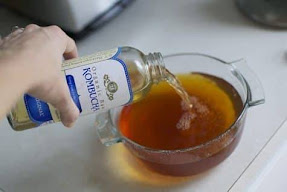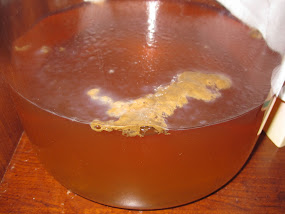
Ah, kombucha. A weird little potion that is as refreshing and energizing as it is flavorful. I love enjoying a cold kombucha when it’s too late in the day for coffee and too early to curl up on the couch with a blanket. And this month, I’m giving a little extra gratitude to this fizzy tea, because January 15 is National Kombucha Day!
The earthy, bubbly beverage has a long history beginning in Ancient China, and has made a comeback in popular culture in recent years. It offers up a crisp, sweet flavor with significantly less sugar (and more probiotics!) than soda products. For an extra step towards sustainability, it can be brewed at home and enhanced with a huge variety of flavors. As we approach National Kombucha Day, there’s no better way to celebrate this tasty tea than learning a little more about it– from the proposed health benefits to the brewing process!
What is Kombucha Anyway?!
Kombucha is a fermented drink made from tea, sugar, bacteria, and yeast. Some folks call it mushroom tea, but kombucha is actually brewed using a scoby– a Symbiotic Culture of Bacteria and Yeast! The scoby is sometimes referred to as the “mother” of the microbial community in a batch of kombucha. It protects the tea from outside contaminants, and also works to flavor and lightly carbonate the tea.

Is It a Miracle Cure??
Although many kombucha enthusiasts insist that kombucha offers a variety of health benefits, including reduction of heart disease risk and protection against cancer, these claims are generally unsubstantiated. However, it is important to keep in mind that kombucha is a much healthier beverage of choice than other popular carbonated beverages, like soda! If you brew your own kombucha, you can add antioxidant rich flavorings like blueberries, or immune-boosting fruits like elderberries. The microorganisms in the brew can also aid in digestion, and the tea in kombucha provides a less jittery energy source than coffee. Whether or not kombucha offers any “added benefits” alongside its wonderful flavor, just enjoy it! It’s a delightfully bubbly, gently caffeinated beverage packed full of flavor.
Let’s Get Brewin’!
Part 1: Making the Mother
Kombucha is a little like friendship bread– to start your very own batch, you will first need to receive a piece of scoby from a friend (or enemy, as long as the scoby is healthy). If you can’t access a scoby, you can also make your own! Here’s what you’ll need to make a scoby and your very own kombucha:
- Clean water and a pot
- White sugar
- Black tea
- Scoby, starter kombucha, and/or store-bought kombucha (unpasteurized, unflavored)
- Glass jar for fermentations
- Cheesecloth and rubber band to cover fermentation jar
- Fermenting bottles or canning jars
The “mother” can be made within 1-4 weeks by boiling water, removing from the heat, and dissolving sugar in the water. Next, steep black tea in the water as it cools. Then pour the tea into a jar and add unpasteurized, unflavored kombucha; cover, and let it sit for 1-4 weeks or until a ¼ inch scoby forms. Keep your scoby in the tea until ready to use for brewing your first batch of kombucha!


Part 2: First Fermentation/Making the Tea
Now that we have our scoby prepared (or brought home from a friend), we can brew a batch of kombucha! Once again we boil water, remove it from the heat, dissolve sugar in the water, add tea bags, and let the tea steep as it cools. Then, pour the tea into a jar, add your scoby and some starter kombucha to the jar, and cover with cheesecloth and rubber band. This jar will sit for about 6-10 days to ferment somewhere dark and room temperature. The longer the fermentation, the less sweet your kombucha will be, so you can ferment to taste! Also remember to reserve some fresh kombucha for your next batch.
Part 3: Second Fermentation/Carbonating the Kombucha
After the kombucha has been fermented to your taste preference, the scoby is removed (very carefully, with VERY clean hands/utensils!) and the kombucha is strained and funneled into bottles for the second fermentation. Add your chosen sweetener to the bottles and seal tightly with a lid; then allow your kombucha to ferment, in the dark and at room temperature, for 3-10 days. Typically honey, fruit, or sugar are used to sweeten kombucha. Remember that adding too much sweetener to the kombucha can cause the tightly closed container to explode! The microorganisms in the kombucha feed on the sugars in the sweeteners, producing carbon dioxide and a tiny bit of ethanol. For your first few batches of kombucha, be mindful of how much sweetener you are adding. You can also “burp” the containers by opening them to release some pressure.

Get the exact recipe for kombucha brewing, and other helpful information including safety tips, here.
Whenever you’re brewing and working with kombucha, keep these tips in mind:
- Do not use metal– It can react with the acidic kombucha and hurt the SCOBY.
- Do not use plastic– It’s more likely to host bad bacteria.
- Keep it clean! We want to grow good bacteria with our yeast, but undesired bacteria can ruin the batch and make us sick.
- If you see mold (generally green, white, or black), toss the whole batch.
Flavoring Kombucha
Whether you plan to purchase some kombucha from your local grocery store or brew your own, remember that there are tons of flavors to choose from! Some folks enjoy the spicy flavor of ginger in their kombucha tea; I tend to lean more towards tart fruits, like grapefruit and raspberry. Read all about how to flavor your kombucha with your favorite ingredients! From blackberry thyme to watermelon jalapeno, there are some crazy flavors out there to play with. Be sure to try a few flavors to find the ones you enjoy!

Try it (or buy it) and see the fun and the benefits of kombucha tea for yourself. I’ll definitely be attempting to grow my own scoby this month in the name of sustainability and foodie adventurism! For more fun information on Kombucha, check out DIY Kombucha and True Brews from the Library. And for some incredible kombucha and kombucha beer, be sure to visit Unity Vibration Brewery in Ypsilanti, or find their brews in local grocery stores. Have fun diving into the bubbly world of kombucha, and remember to give thanks this month to the incredible and weird community of bacteria and yeast!